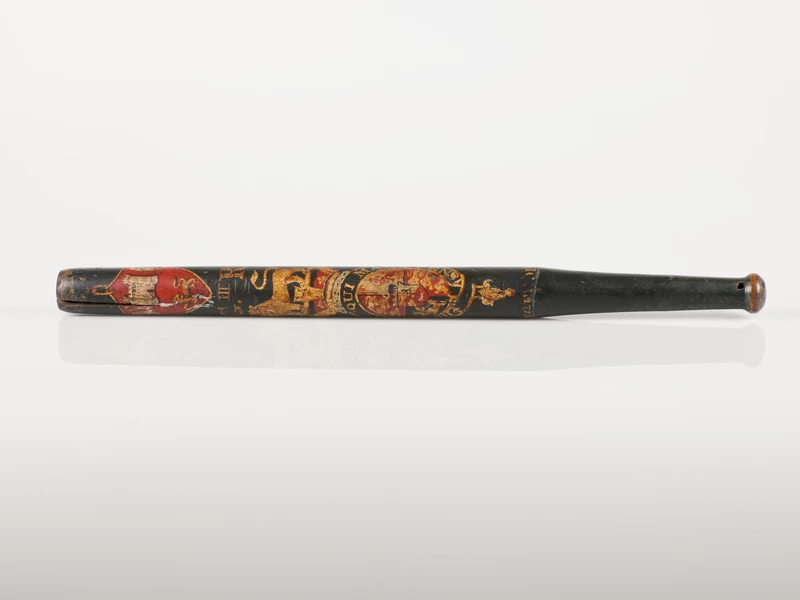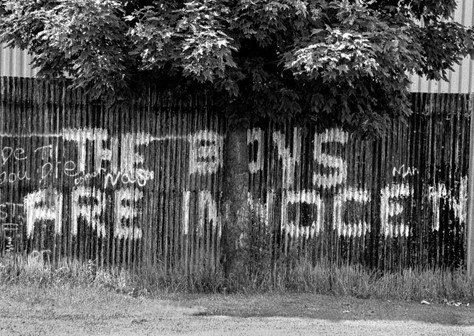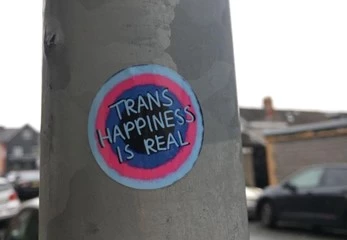Graffiti – a contentious topic, to say the least. Is it art, or a public nuisance? Should it be decriminalised? Is it vandalism?
From what I can gather, the answers to these questions often render divides down class and racial lines. For example, if you are white and middle-class, you are far more likely to dismiss walls full of graffiti and think it unsightly – regardless of the message being conveyed. You are more likely to see a messy tag on a wall and bemoan the downfall of society or write an op-ed about anti-social behaviour in young people. There’s something about graffiti that inspires a clutching of pearls and a shaking of heads.
Growing up in England in a working-class town surrounded by middle-class suburbs and affluent villages, my school was a real mixed bag. Kids whose daddies had second homes in France rubbed up with kids from housing estates, kids in care homes, and kids with families just about getting by. Yet, we were all taught from a young age that graffiti was this sort of awful affliction to the community. We were taught about the broken windows theory, warned against peer pressure, and made to watch videos of kids talking about regretting their ASBOs.1 It was effectively a moral panic about anti-social behaviour, and it taught us that graffiti was ugly, graffiti was dirty, graffiti was the product of bored chavs with nothing better to do. And yet, most of these teachers would have probably looked at a Banksy and called it a stirring work of art. So, fundamentally, what’s the difference here? Is it politics? Is it a case of who does it and where they do it?
1 (David Hurn, Graffiti supporting the Cardiff Three)
The image above is one taken by photographer David Hurn, and it depicts a graffitied message on a wall. The message reads, in large block capitals, “THE BOYS ARE INNOCENT”. Separated from its context, you may think that this was just someone letting off some steam, committing a light act of vandalism out of boredom or restlessness. In reality, this piece was incredibly politically charged.
On February 14th, 1988, a young girl named Lynette White was brutally murdered in Cardiff’s docklands. She had been violently stabbed around fifty times. What followed her death then became one of the most notorious miscarriages of justice in the UK. Despite eyewitness testimony placing a white man covered in blood near the scene, South Wales Police arrested and charged five young Black and mixed-race men. One of these, Stephen Miller, was Lynette’s boyfriend at the time – but the others did not know her at all, or each other. Despite no real evidence against them, they were held in prison on remand for two years before undergoing Britain’s longest murder trial in 1990. Two men – Ronnie and John Actie – were acquitted. Stephen Miller, Tony Paris, and Yusef Abdullahi were all found guilty and sentenced to life imprisonment. Due in no small part to relentless public campaign by their families, the convictions of the Cardiff Three were quashed by the Court of Appeal, and the men were released in 1992.2 It goes without saying, though, that this experience changed their lives and the lives of their families and friends. This tale of structural police racism and bad practice had real victims and real consequences.
This is the context of the graffiti that David Hurn photographs for us. Not just bored kids mouthing off after all – but part of a dedicated social justice campaign to free three men whose lives had been destroyed by systemic police incompetence, corruption, misconduct, and racism. The writing on this wall, then, is rebellion. This graffiti is an act of resistance, defiance, and challenge, aimed at an audience who is perhaps more passive – for example: commuters on their way to work; young people who claim they’re not political; police officers on their regular beats. It challenges these people to consider the context in which these words were written, and raises awareness of the case of the Cardiff Three without even directly mentioning their names.
This is more than just a tool for raising awareness, though. It’s a message of solidarity. Hurn does not specify when this picture was taken, nor is it clear when the graffiti was made. It is likely, however, to be part of a very specific act of protest. In 1991, there was a large and historic Free The Cardiff Three march. Hundreds of campaigners and protesters made their way from Butetown to Cardiff prison in the city centre, attended by well-known American Baptist minister and black rights activist Reverend Al Sharpton. It is this march and the presence of Rev. Sharpton that really launched the families’ campaign into the national media spotlight, with archival footage from the march showing the heavy presence of both journalists and police. Without the efforts of these campaigners, it is likely that the case would not have made it to the Court of Appeal. Now, this is a projection, but it’s easy to imagine protesters – buoyed up by the feeling of community and solidarity, really feeling like their effort to push for change was being recognised – grabbing a can of paint on their way home from the protest and creating the message that has now been immortalised by Hurn’s picture. ‘The Boys Are Innocent’, and this community knows it.
Solidarity. Rebellion. Defiance. All of these are outcomes of graffiti like the one Hurn’s picture depicts. And it isn’t old news, either. This is something that still happens today in this form. In the minutes before pulling into Cardiff Central train station, you are treated to a view out the train window of a graffitied ‘KILL THE BILL’ message under one of the bridges (the ‘bill’ in question being the current draconian Police, Crime, Sentencing, and Courts Bill which would significantly curb rights to protest amongst other freedoms). I don’t have a photo of it, but seeing that message displayed by the train station makes me smile every time I see it.
2
And it’s not just graffiti anymore – there’s been a recent shift locally to the use of stickers to convey political and social messages. If you live around Cardiff, you may have seen these adorning various lampposts and road signs, but if you haven’t had the privilege, then the sorts of things I’m talking about can be seen in Images 2–4. I’ve heard it be said that technically, legally, it doesn’t count as graffiti and is therefore perfectly okay to do in the eyes of the law.3 Now, I’ve tried to find evidence or documentation of this and I have failed – but I haven’t got into trouble for doing it yet! In the area, plenty of people use a variety of designs to communicate various messages. I spend a depressing amount of time peeling off ones from a local anti-vax contingent, but much more time putting up ones with messages such as ‘Kill The Bill’, ‘Black Lives Matter’, ‘Refugees Are Welcome Here’, etc. Regardless of the message, the convenience and accessibility of vinyl stickers appears to be a natural evolution of people wheat-pasting political posters to walls. Plus, you can do it in broad daylight and rarely get a funny look.
3
My favourite designs to put up and to see in the wild, though, come from a people very dear to my heart: the local trans and queer community. There are an abundance of these stickers around, with designs varying from simple messages of support to a complicated display of in-jokes and trans cultural things that are not supposed to be comprehended by the average commuter.
4
For example, in Image 4, there is a square sticker from local self-proclaimed ‘trandal’ (trans vandal) N3ko, displaying a character from Zombieland Saga with rainbow text reading ‘SHUT THE FUCK UP TERF’. For someone not embedded in local queer and trans culture, the meaning of this sticker is limited. Perhaps you know what ‘TERF’ means, (Trans-Exclusionary Radical Feminist), and think that it’s a fairly straight-forward pro-trans message. However, it’s also somewhat of an infamous image in local and online circles. The long and short of this saga is that this meme was sent on Twitter to SNP MP Joanna Cherry, who then took it upon herself to print it out and bring a copy to a meeting of the Human Rights Committee at Westminster, using it as part of an argument that Twitter doesn’t do enough to protect women in Parliament. This is hilarious for a whole bunch of reasons – not least the fact that the meme is in no way a threat of violence, and that better attention could be focused on the very real and detailed death threats that ministers get sent regularly. It’s also amusing for the very idea that a trans person could be construed as a credible threat in this scenario, where the offended party is a Member of Parliament who uses her position of power to oppress a maligned community. Whilst online abuse is a serious matter, in this dynamic, it will always be the MP sat on a Human Rights Committee with the upper hand.
There are other similar contexts to a lot of the trans rights stickers in the area and the simple fact that a lot of these designs are essentially shitposts on lampposts really betrays the purpose of these stickers as being rooted in solidarity over awareness. The purpose of putting these stickers up is not to change anyone’s mind, or even to create any sort of awareness, it is simply a show of solidarity for other queer and trans people. It’s a way to earmark a community as a safe place for trans people to express themselves, to remind trans folk going about their daily business that they are loved and not alone, to express a joy and a creativity that is often suppressed. Trans lives aren’t tragedies, and these stickers are defiant and crucial expressions of queer joy in a political climate that is increasingly hostile to trans and non-binary people.
These stickers, as silly as some of them are, remind me I’m not alone. I am a part of a long chain of marginalised people using the medium of street art as protest, solidarity, and empowerment.
I encourage you to get involved.
Georgia is a queer writer and student in Cardiff, currently studying for their MTh. They specialise in queer theology and hoarding houseplants. In their spare time, Georgia enjoys baking, gardening, and hanging out with their girlfriend! You can find their shenanigans on Twitter @GeorgiaTDay2 or Instagram @georgiatheday.
Notes
1 ASBOs don’t even exist anymore you guys!
2 This is an incredibly brief overview of a very complex case, and I recommend watching BBC 2’s three-part documentary series A Killing in Tiger Bay (2021) for a much more comprehensive look at the case – including interviews with several of the accused and audios from their original police interviews.
3 Interestingly, there’s been a recent incident in Oxford where local police have categorised specifically hateful transphobic stickers as a public order offence, but this isn’t a precedent by any stretch (and also has nothing to say about the pro-trans stickers activists have left to counter the hate). http://stickersagainsthate.com/ https://www.telegraph.co.uk/news/2019/10/14/police-response-transphobic-stickers-branded-extraordinary/






